Shevlin Sebastian's Blog, page 31
January 8, 2020
Sweet solutions for fallow fields

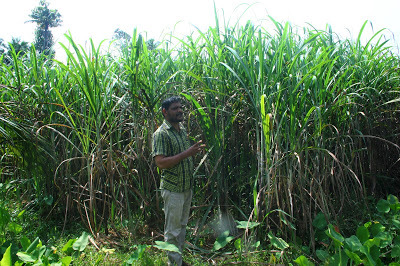
Sugarcane cultivation is being tried, after decades, in the Kizhakkambalam panchayat, near Kochi
Pics: A drone's view of the sugarcane fields; farmer Suresh Kumaran
By Shevlin Sebastian
Suresh Kumaran wakes up one morning at his home in Kizhakkambalam and shakes his head. A year ago, he had been a dental technician in Goa. Now, he is a farmer, not of paddy, but sugarcane. He had returned home, because his father had been a farmer and Suresh could not resist the pull of the land. And, for the first time in decades, a new crop is being tried on fallow paddy fields.
It is 7.30 a.m. when Suresh steps out towards the fields. “This place was bought by a few doctors to start a hospital but because these are paddy fields, they were not given permission,” he says. He walks between the stalks. It has reached a height of 10 feet. “In a couple of months, it should reach 14 feet,” he says.
He points to the ground beneath the stalks and water can be seen. “Since these paddy fields are next to a stream, there is always water beneath,” says Suresh. “Sugarcane needs a lot of water.”
Soon, a few workers come. They sprinkle organic pesticide, a mix of urea, potassium and neem oil, and use spades to mix it with the mud. A specific variety called Madhuri is being used. “This variety is known for its sweetness and sturdiness,” says Suresh. “We got the plants from Pathanamthitta.”
They are expecting about 40,000 kgs from a single acre. And if all goes well, from that, 4000 kgs of jaggery will be made by a four-member Kudumbasree team. They have taken a government loan of Rs 1 lakh through the ‘Joint Liability Groups for farming’ scheme. Suresh has contributed Rs 70,000 while the rest has been given by the Twenty20 Kizhakkambalam Department of Kitex Textiles Limited. The company is also providing manpower, machinery, fertilisers and expert advice.
As to why it was decided to try sugarcane cultivation, in an area of 10 acres, Sabu M Jacob, the managing director of Kitex says, “Because of its potential as a cash crop, and for its suitability to the Kerala climate. Sugarcane can remain in the water for up to three weeks without rotting – this could be a plus when you consider the recent flooding.”
Sabu also says that there is a huge demand for pesticide-free jaggery in Kerala. “There are also plans to make biodegradable plates and cutlery from the waste,” he says. “Later, we might go in for the cultivation of jasmine flowers because of its high demand and profitability. I believe this is a good way to generate self-employment.”
(The New Indian Express, Kochi)
Published on January 08, 2020 22:39
January 7, 2020
The meaning of existence
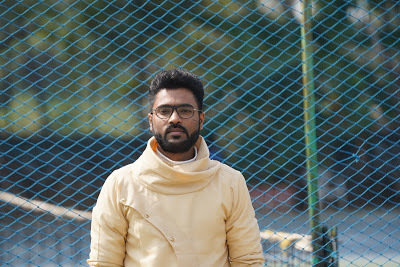

Singer Vyaasa M, a Mumbai-based Malayali, talks about his well-received new single Wajood-e-Sabab and his musical journey
Youtube link: https://www.youtube.com/watch?v=sILIH...
By Shevlin Sebastian
On an idle morning, the Mumbai-based singer/songwriter Vyaasa M was flipping through videos on YouTube when he came across a commencement speech by American talk show host Oprah Winfrey at the Stanford Graduate School of Business in 2014. At one point she said, “Once your personality meets your purpose in life, nobody can stop you.”
It sent a jolt through Vyaasa and he immediately said to himself, “How true.” Quickly, he got in touch with a lyricist friend Shamsher Singh Beniyaaz and they wrote the lyrics. The song, made with the help of producer Himonshu Parikh, is called Wajood-e-Sabab. “Wajood means existence and Sabab is reason,” says Vyaasa. “So the Urdu words stand for ‘the reason for existence’.”
The video begins with a long-haired bearded young man running down a dark street with a troubled look on his face. Then he enters his house, goes to the bathroom and looks at the mirror and does not like what he sees. He rushes out and flips through his mobile phone.
Then he is shown writing lyrics and singing. “But then he does not sing in public because he is unsure,” says Vyaasa. Meanwhile, he is an underperformer in his office and his boss castigates him. But, over a period of time, he reaches a stage when he wants to bring out the talent inside him. So, he decides to leave his job and start singing. But when he approaches music companies they reject him. One said, “You are good but not great.”
Then he decides to put out his song and asked, on Facebook, for a team to shoot the video. The finale happens when he releases the song.
But what is captivating and hypnotic is the singing and some excellent electronic music. The song, like all good ones, grows on you the more you listen to it. Apart from Vyaasa, his friend Vivek Hariharan, a professional singer, also lends his voice.
Listeners are enthralled. Vijesh Divakaran says, “Great picturisation. The music gets deeper because of the video. It was motivational.” Devesh Agrawal says, “Awesome song... Awesome lyrics... Awesome topic... Wajood-e-sabab... Reason for existence... Awesome job guys.” Pavithra Nair says, “Very catchy tune. Loved it.”
Vyaasa wanted to tell a story that would resonate with everybody. “There are many comments on YouTube and Instagram where people say they have a friend like the man in the video or seen a guy like him,” he says. “So I am happy with the response.”
Vyaasa, a Malayali, grew up in Dombivli, a suburb of Mumbai, where he studied at the St. Therese Convent School. Throughout his schooling, the thought of music never came to his mind. “I lived in an environment where education was regarded is all-important,” he says.
Later, he got admission into the Institute of Hotel Management and Catering Technology at Kovalam. It was during this time that he began to take part in festivals and realised that he had a talent for music. After he graduated in 2012, he returned home and told his parents he wanted to be a musician. “They thought I was joking,” says Vyaasa.
But Vyaasa remained steadfast. He worked for a couple of years, to clear off his student loan, and then started his full-time music career. He has worked as an assistant keys arranger, played keyboard and became a music arranger. “It is a competitive industry,” he says. “But I am glad I am on the journey.”
Asked the prospects for independent music, Vyaasa says, “After the 1990s, this is the best time. There is a digital space to show your work without the need to get approval from anybody. We can now create content in parallel with the mainstream.”
Vyaasa’s next single, ‘Kyu Tumne? (Why have you?)’ will be released soon. “It is about a heartbreak, but sounds like a love song,” he says.
Published on January 07, 2020 22:39
January 6, 2020
Giving when it matters
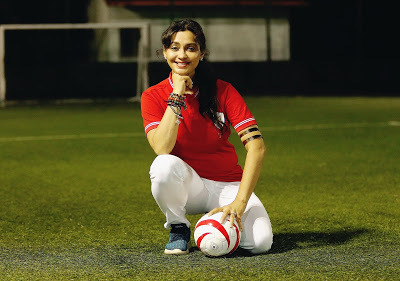
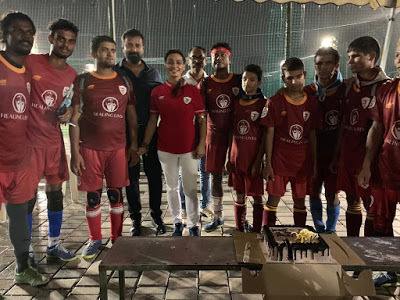
Through her NGO, Healing Lives, corporate professional Jani Viswanath has changed the lives of blind football players, villagers in Bundelkhand as well as medical students in Kenya
Pics: Jani Viswanath; photo by Arun Angela. With the Indian football team
By Shevlin Sebastian
The rain was pelting down, looking like little icicles, as it hit the floodlit football pitch of the Jogo ground in Kochi. But in the enclosed parking area, a group of footballers, of the Blind Football Academy, stood around, as a petite woman, clad in a maroon T-shirt and white slacks, bent low, towards a stool, and cut a chocolate cake inscribed with the words, ‘Best Wishes to Team India’.
The boys sang ‘Happy Birthday to you’. Soon, Indian team coach Sunil Mathew and MC Roy, head of projects at the Society for Rehabilitation of the Visually Challenged made Jani bite into a piece of cake.
The Dubai-based Jani had come to Kochi to encourage the players a few days before they jetted off to Thailand to take part in the IBSA Asian Championships held at Pattaya, Thailand in early October. Jani, a co-founder of the Healing Lives Foundation is a major sponsor. And she had come to inspire the team.
However, when they lost their first two matches, against the higher-ranked China and Thailand, Jani called them and said, “Look, boys, this is your first international tournament. I don’t care if you win or lose. But I do care that you lose in a way that makes us all proud.”
It had the desired effect. The next day, the Indian team beat the higher-ranked Malaysia team and ended up in fifth place overall.
It was serendipity that brought Jani to support blind football. One day, while chatting with some of her Mumbai-based friends, they informed her that a national award-winning filmmaker from Assam, Bidyut Kotoky had run out of funds while making a film, ‘Xoixobote Dhemalite’ (Rainbow Fields).
So Jani stepped in as producer. While doing so, she came in contact with noted thespian Victor Banerjee who was acting in the film. Victor told Jani that he ran the Moran residential blind school at Moranhat, in Dibrugarh, Assam. “I was very intrigued and told him that I would like to see it,” she says.
When Jani finally saw it, she was very impressed. “It was a beautiful and well-maintained school,” she says. “It was there that I saw blind football for the first time.”
Jani also attended the North-East Blind football tournament in Shillong in January this year. “From then on I have been backing every tournament that the blind players have been playing,” says Jani She also ending up supporting Victor’s school and is a member of the board of trustees.
The funds for the NGO comes from her family. Her husband Jonathan Jagtiani is the founder of Home Center, a part of the Landmark Group, which is one of the largest retail groups in West Asia.
And after 18 years as a corporate professional, Jani also wanted to do something more. “Money gives you the luxury of choice, but it is not everything,” she says. “Giving back to the community was something that was taught to me by my late father, Dr T. K. Viswanath [an educationist and a former diplomat].”
Thanks to her father’s posting, Jani grew up in Kabul. She studied in an Italian school called Michaelangelo where they had to attend Sunday mass and learn the Bible. “I also enjoyed the culture of my Muslim friends,” she says. “At home, I was reciting the Gayatri Mantra. I was lucky to have the influence of three religions simultaneously. It changed my perspective. Today, my religion is humanity. I don’t care what colour, language, religion or physical shape a person is, as long as I can help in some way.”
So the NGO helps medical students in Kenya. These are brilliant kids who have got admission to the first year but do not have the resources to continue. So Healing Lives pays the tuition fees for the remainder of their medical degree. They also conduct free medical camps in villages and slums twice a year. In India, they have also adopted five villages at Bundelkhand.
“They used to suffer from drought every year,” says Jani. “We built dams, ponds and wells so that they became self-sufficient. We supply sweet water for drinking every day to each village, provide free seeds from our seed bank and give farmer's training on smart irrigation.”
And these interactions have been an enriching experience for Jani. “It is easy to send money to an NGO and assuage my conscience,” she says. “But I prefer to go there physically and see what is happening. These are the discarded places on the planet. The poor have a purer heart than the rich. When you have lots of money, you have so many distractions. It dilutes your personality. So you are not able to retain that purity and simplicity that you are born with. But through my charitable work, I have found myself.”
Published on January 06, 2020 22:16
January 5, 2020
In step with the times
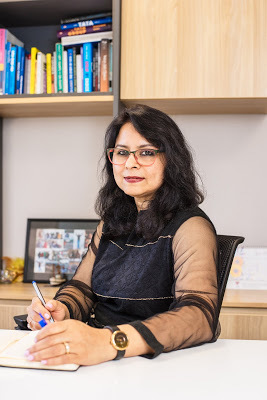
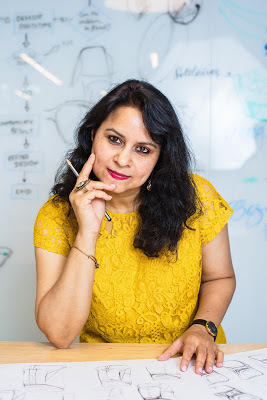
During a recent visit to Kochi, Revathi Kant, the Chief Design Officer of Titan, talks about how the company stays relevant and how design plays a key role
By Shevlin Sebastian
On the stage at the Kochi Design Week, at the Bolgatty Palace, for a panel discussion on ‘Design for Startups and Innovation’ Titan’s Chief Design Officer (CDO) Revathi Kant cuts an elegant figure in a cream saree with a lemon border. And not surprisingly, she has a gleaming Titan watch on her left wrist. She said, “Since disruption is the only way forward, we are going beyond manufacturing watches to wearables.”
As the CDO, Revathi has a team of 70 designers to make new designs for watches, jewellery and eyewear. “Our watch brands like Titan, Sonata, Raga and Fasttrack are aimed at specific consumer segments,” she says. “And based on the market and customer requirements, we keep building new products.”
For Diwali this year, the company focused on retro and vintage designs for men and launched a collection called Maritime, which has boat-shaped as well as 3D sea wave pattern dials. “For women, we have launched Raga Facets, which highlights different aspects of today’s modern woman,” says Revathi. “In Sonata, we target value-conscious customers, while Fastrack is trendy and youthful.”
To produce designs that have a resonance with consumers, the designers try to understand the lifestyle and behaviour of the consumer. “They spend time at the stores,” says Revathi. “Sometimes, they go into the market. They analyse the consumer research. The reasoning is that if you can understand the customer, only then can you do a suitable design.”
But even if the design is successful, it still goes through endless changes, so that it remains relevant for the consumers. The first Edge watch, which came out 15 years ago, had a simple, sleek and classic look. Then after a few years, the Edge was made larger, and a lot more contemporary. A date was introduced and it was made water-resistant.
The latest is called the Edge Ceramic. “It is a sleek product,” says Revathi. “The case and strap are ceramic. It is a beautiful collection and is doing very well (the prices range from Rs 19,000 to Rs 24,000). What the customer wanted years ago is not what the customer wants now. The designers go on a journey with the watch.”
But has the watch lost its importance since people use the mobile phone to check the time? Revathi smiles and says, “Nowadays, people don’t wear watches to see time any longer. It is an extension of your personality, to complete your dressing.”
Revathi has completed 29 years with Titan. She joined the company as a trainee, straight from college. But she gives credit to Titan because they gave her a lot of freedom to innovate, to come up with new things, and to grow. “I also took risks in my career, by jumping from marketing to design and realising that the latter is what I want to do,” she says.
Asked to give tips for young women who are starting out, Revathi says, “You should enjoy what you do. Try new things. Take risks. Because you don’t know what is best for you, until you try many things. It is important to be open to learning all the time irrespective of your level and age. You have to learn and contribute quickly.”
Finally, Revathi is very clear about the type of leader one should be. “It is very important to be a good human being,” she says. “It is also necessary to build good relationships at your workplace, with your seniors, peers, and juniors. People love to work for leaders who care. Being empathetic and a good mentor are vital attributes.”
Published on January 05, 2020 22:07
January 2, 2020
Harith Noah, from Kerala, is all set to take part in the Dakar Rally 2020
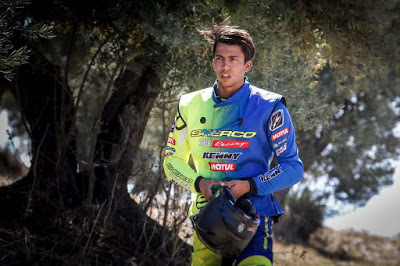

By Shevlin Sebastian
It is 9 a.m. on a weekday in the town of Sauve in Southern France. Two young men set out on cycles. Harith Noah and Michael Metge chat as they ride on and on… more than 100 kms. They return, break for lunch, take a nap and in the evening they go to the gym.
Both men have been in strenuous training for the past several months. And the reason is simple. They are going to take part in one of the most demanding races on the planet: The Dakar Rally. The 13-day event begins on January 5. The distance to be traversed is 7800 kms. Despite the name ‘Dakar’ (which is in Senegal), the rally is taking place in Saudi Arabia, albeit for the first time.
In the bike category, more than 250 riders are expected to participate. From India, there are two Indians: one is the Shoranur-native Noah and the other is CS Santosh from Bengaluru. Noah is a member of TVS Racing which is in partnership with French motorcycle manufacturer Sherco. And the team is called Sherco TVS Rally Factory Team. Noah will be riding the company-built RTR 450, which can attain speeds of over 170 km per hour.
A few days ago, Noah returned to Shoranur to spend Christmas with his parents, Mohammed Rafi KV, a businessman, and Susanne, an artist and farmer. Noah is a lean muscular man with not an ounce of fat anywhere on his body.
Their house is set in a sylvan setting of 12 acres, where there are numerous trees as well as a few paddy fields. Two dogs run around happily. A cat stretches his body on the verandah and enjoys a lazy yawn. Noah looks relaxed but he does admit he is feeling nervous. “It is one of the biggest races of my career,” he says. “My target is to perform well and finish the race. I am keen to get the experience, so that I can do well in future.”
It was his father who unwittingly ignited the passion in him. On Noah’s 16th birthday, Rafi gifted him a motorbike. Within a week, Noah learned to ride and took part in a local race and came last. That was the only time he has come last. Today, in his house, there are more than one hundred trophies. He has been a National Supercross Champion several times in the SX1, SX2 and Class 2 categories.
Noah's international rally debut was in the 2018 Rallye du Maroc in Morocco which he completed even though he sustained an ACL (anterior cruciate ligament tear) and meniscus injury during the second stage of the race. He took everyone by surprise when he finished seventh in his comeback race, the 2019 Baja Aragon. In between all this, he secured a degree in sports science from Manchester Metropolitan University.
Meanwhile, Rafi brings out the gear. There is a helmet, gloves, goggles, earplugs, to cancel out the noise, a body armour jacket, knee braces and riding boots. “It does not mean that when you fall, you cannot get injured, but it protects you a bit,” says Noah. “The trick is to try to roll when you hit the ground, but it is not a foolproof method.” Thus far, the 26-year-old has undergone two collar bone as well as knee surgeries. “This is part and parcel of racing,” he says, with a smile. “But I am ready now, to do my best.”
(The New Indian Express, Kerala editions)
Published on January 02, 2020 22:43
January 1, 2020
The meaning of life
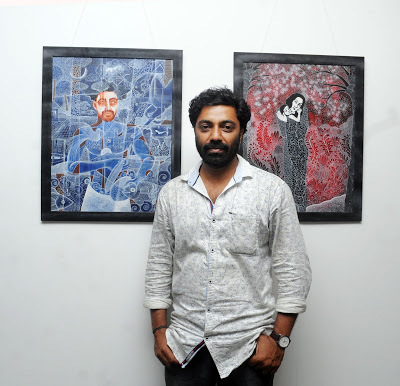
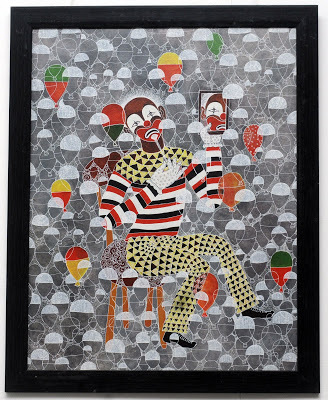
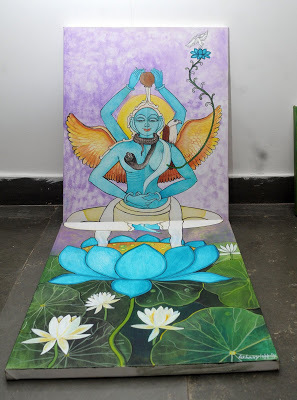
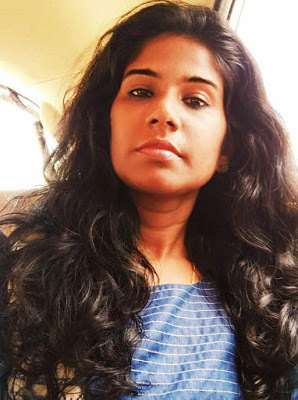
Artists at the ‘Unbounded’ exhibition at the Kerala Museum in Kochi focused on this theme in varying styles
Photos: Sumesh K Shanmugham; The Joker; Work by Lekha Vyloppilly
By Shevlin Sebastian
One morning, artist Sumesh K Shanmugham read the news of the arrest of a Mollywood actor, who was good at playing comic roles. Feeling inspired, he went to his studio and drew a joker. He has the clown’s make-up, including the red nose but the eyes are downcast, with downturned lips. The joker is using a straw to blow bubbles. Not surprisingly, the work is called ‘The Bubble Maker’. All around balloons are floating about.
“Most jokers are sad by nature,” says Sumesh. “There is a sadness behind every joke. The balloons stand for meaninglessness and for hollow people, who have nothing to offer.”
Sumesh employs an unusual style. While most artists put black on a white background, he is using white ink on a dark background, by using a Rotring pen.
In another black-and-white work, a shirtless man wearing a white half-mundu, with hands upraised, is blowing a large bubble skywards. At one side there is a staircase going upwards. You can also see a horse, a large fish, an empty boat on a dark river, floating buildings and many bubbles.
“This is the story of this man’s inner life,” says Sumesh. “I am trying to show the rough side of contemporary life. The bubbles represent people who make a lot of noise, but are empty inside. The boat and the fish represents the darkness of life.” All fifteen works are eye-catching and attractive. “Yes, I am lucky, people like my works and many buy them,” says this full-time artist.
Sumesh was displaying his works at the exhibition, ‘Unbounded -- transcending boundaries through the universal language of the visual arts’ at the Kochi Museum.
Another participating artist is Lekha Vyloppilly. She has drawn a male/female figure. There is an eagle behind the left shoulder, while a snake is coiled around the neck. “The eagle represents life while the snake is death,” she says. “Death is part of life. But despite the presence of death, we must think positively.”
Water, from a small bowl, is poured over the head as an act of self-purification. “We become a new person and start a new life,” she says. “That’s why I drew wings behind the person. From the breast, a lotus is growing.”
Most of her works, she says, are based on self-realisation, love and desire. “It is a blend of traditional stylisation with contemporary motives,” she says.
As for artist Girish Kalleli, he has drawn faces of the people in his neighbourhood in Muvattupuzha. These included the anchor of a local TV channel, a labourer, a temple priest, a youth and the artist’s wife and daughter. During the time he worked on these images, he realised that everybody has a mask. “We wear them at home, in the workplace, in front of our spouses, relatives, parents and children,” says Girish. “Where is the real person is the question I ask myself.”
Finally, there is TG Jyotilal, who has done a reddish image of a body on a spike in front of tombs and temples. He has focused on a time, during the 9th century when the Brahmins used to persecute the Jains in Kerala.
(The New Indian Express, Kochi)
Published on January 01, 2020 23:45
December 30, 2019
When children are exploited...
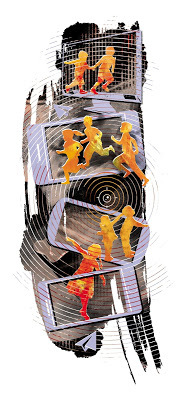
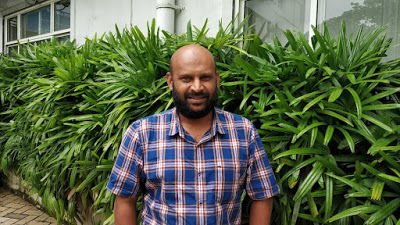
Rights activist Mohamed Mustafa Saidalavi talks about the numerous child sex abuse videos that are available
Illustration by Amit Bandre; Mohamed Mustafa Saidalavi
By Shevlin Sebastian
At the seminar titled ‘Child Pornography and its Perils’, conducted by the NGO, ‘Raising Our Voices’ at Kochi, recently, child rights activist Mohamed Mustafa Saidalavi tells the audience, “Close your eyes and count to 13.” Dutifully, the audience does so. Then Mohamed says, “Now open your eyes and you should know that every 13 seconds an Indian child sex abuse video is being reported globally online. In 2017 there were 2.4 million videos in India.”
Mohamed tells an incident which was told to him by an international expert. A man in a Middle East country cut his wife’s womb, took out the foetus and tried to make love to it. He took a video and sold it on the internet.
“Suppose you are a rich but sick paedophile who wants to see such things,” says Mohamed. “There are people who will supply it. It can be put it on a flash drive and sent. Or it can be put it in a particular drive from where it can be accessed online.”
Much of these activities take place in the Dark Net through an encrypted part of the Internet called the Tor Network. This is not readily accessible. “The legitimate web which we are using is a tip of the iceberg called surface web. Darknet and other encrypted web are the remaining areas,” says Mohamed.
Mohamed got interested in the subject when he came across a case among his relatives. There was a 12-year-old boy who got addicted to seeing porn. Then after a while, there arose a desire in him to see children of his age doing sex.
“He got connected with a group in New Zealand on the Dark Net,” says Mohamed. “To enter it, you have to prove you are a paedophile by producing one video. Once you post it, then they will know that you are not the police and will give you the code to enter and access all their materials. So, he gave sweets to his 12-year-old cousin, and tried to do sex with her. But his parents caught him before it went further.”
According to Mohamed’s research, the vast majority of child porn videos feature boys and girls between the ages of 10 and 13. “The buyers of child pornography are usually well-off people,” says Mohamed. “But women are also watching and producing films, because of poverty.”
And women have advantages. “They can easily access the child,” says Mohamed. “She makes the child do something to her. Or she does something to the child. It is put up in the WebCam Child Sex Tourism network.”
He recounts the well-known incident of a woman who took her daughter to a cinema hall along with her boyfriend who was a rich businessman in Kerala. “The man molested both of them but he was caught by the night vision cameras,” says Mohamed. “She did it for the money.”
Mohamed met the principal of a school in Thrissur. “He told me that he came across seven under-age children who were abused,” says Mohamed. “Out of them four were raped by the father. But three of them thought it was fun and there was nothing wrong with what their father did.”
As to ways to stop it, Mohamed says, “To be honest, it is like trying to stop an ocean. But now artificial intelligence is being used to travel through the Dark Net and catch these people. Kerala Police is one of the best in India. They are keeping on catching people who watch and make child porn. So I am happy about that.”
(The New Indian Express, Kochi)
Published on December 30, 2019 01:47
December 26, 2019
Planting a seed
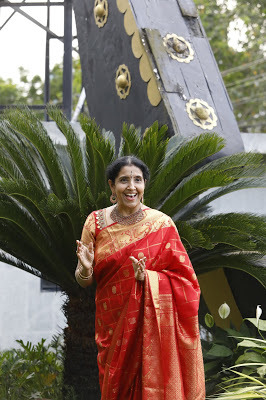
The noted US-based danseuse Bala Devi Chandrashekar is opening a branch of her Bharatanatyam school in Kochi
Photo by Arun Angela
By Shevlin Sebastian
When Bala Devi Chandrashekar sweeps into the lobby of a five-star hotel in Kochi, she catches the eye with her elegance. The Kanjeevaram saree is a mix of saffron and gold. Her earrings are also a mix of emeralds and rubies. So is her necklace.
Bala, a Bharat Natyam exponent, is the founder of the Shree Padma Nrityam Academy of Performing Arts at New Jersey. But now she has come to Kochi to lay the groundwork for opening a centre at Kakkanad. Her former student Vidya Hari will be the Director. The inaugural ceremony is slated for January 5.
“Kerala is steeped in art and culture,” she says. “So, I thought it would be appropriate to have a centre in Kochi. It would be a place, not only for the students but for scholars of literature, art, music and theatre.”
Unusually, Bala takes an intellectual approach to the art form. She takes subjects based on ancient texts and follows it up with intense research. Thereafter, she collaborates with renowned scholars to produce a dance for a contemporary audience. Thus far, she has produced eight critically-acclaimed productions including Nandanar Charithram and Krishna Arpanam.
And as she performs all over the world, she is amazed by the power of classical Indian art. After a performance in London, a pregnant woman went up to her and said, “I am going through a lot of pain.”
She told Bala she had suffered three miscarriages. “I feel that if you touch me, it will all be fine,” she said. So, Bala hugged her. And later, the danseuse came to know that the woman had delivered a healthy baby. “That was soul-stirring for me,” says Bala.
And she says that nowhere in the world can you see the depths in literature, music, dance and theatre as it is there in India. “The people abroad find our culture very powerful,” says Bala. “They are looking for something authentic which also has a history.”
As for Bala’s personal history, she grew up in Hyderabad. Showing a talent for dance early, she trained under Guru Jayalakshmi Narayanan and Dr Padma Subrahmanyam in Chennai. And unlike most artists, she was also academically inclined. She secured masters degrees in management, public administration and human resources, and an M Phil, too. Soon, she began teaching.
However, in 1992, she left for Abu Dhabi where her husband had got a job. While there she started teaching dance and began a corporate career. She also taught business ethics in the local branch of the City University of London. In 1999, the couple left for New Jersey where she started her academy. She also began a teaching career, too. Today, she is an Associate Scholar at the University of Pennsylvania.
However, the more she travels, the more she feels that despite stating that Indian culture is very powerful, art is beyond any country. “I don’t think art can be compartmentalised as belonging to India, Africa, Europe and Latin America,” says Bala. “You don’t have to have an Indian heart or mind to produce art. It comes from the soul. Many a time when I am performing, several non-Indians connect with me so instantly. So art is beyond a country.”
She gives an example. Once a Bedouin invited Bala to perform the ‘Uddhava Gita’ in Spain. The man said, “I called you because Uddhava is my guru.”
Uddhava Gita is Chapter 11 of the Srimad Bhagavatham. “It is one of the toughest chapters,” says Bala. “The subject matter in all our epics is meant for people all over the world. It is universal because it transcends religion and caste.”
Published on December 26, 2019 00:47
December 24, 2019
Kerala Kalakshethra stages Kathakali play on the birth of Jesus Christ
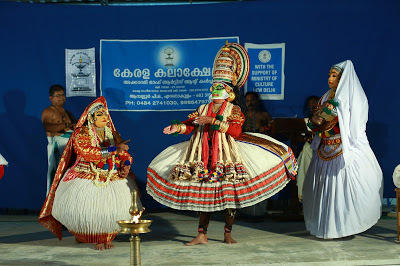
By Shevlin Sebastian
Pic: Joseph pleads with the prostitute to give shelter to him, Mary and the Baby Jesus
One morning, in early December, RLV Gopi, founder of the Kochi-based Kerala Kalakshethra met his friend KV Moncy, a Christian. The latter told Gopi, “Can you do a Christmas play?” Gopi, who is a Kathakali maestro, thought it was a good idea. He spoke to his colleague, Kalamandalam Ganesh. The latter read the Bible as well as writer Paul Zacharia’s novel, ‘Aarkariyam’, wrote the script and titled it Raksagan (The Saviour). Then Kalamandalam Sudheesh composed the music.
The story is a familiar one for Christians. King Herod of Judea came to know that a baby had been born who would become the future King. “So he ordered his soldiers to kill all babies below two years of age,” says Gopi, who directed the performance. “Joseph and Mary, along with the Baby Jesus escape to Egypt. On the way, they stop at a brothel for the night. After a while, a soldier, with blood-stained clothes, arrives. Quickly, the trio is placed in another room. The prostitute prepares a warm bath, food and a change of clothes for the soldier.”
They start talking. The soldier talks about how he has killed several babies. “The killing of innocent babies is a greater sin than that of being a prostitute,” says the woman. The soldier feels guilty and repentant. As he goes to take a bath, Joseph, Mary and Jesus, with the help of the woman, make good their escape. The prostitute does not know he is the Baby Jesus.
The dance drama was performed at the Karayogam of the Nair Service Society at Ambaloor recently. Fr. Vincent Parambathara, of the nearby St. Francis Church, who inaugurated the event, says, “It was a very nice performance.”
Indeed, the emotions shown were intense. In one scene, Joseph, accompanied by his wife and child pleaded with the woman to give them shelter. She listened attentively, shook her head in horror when told about the killings and then welcomed them with open arms. The gamut of expressions was impressive to see.
This is the first time in the 12-year history of the Kerala Kalakshethra, which is supported by the Central Ministry of Culture, that they have done a Christian theme. “If opportunities come up in future, we will do more such plays,” says Gopi.
(The New Indian Express, Koch)
Published on December 24, 2019 19:46
December 19, 2019
Getting better by the day
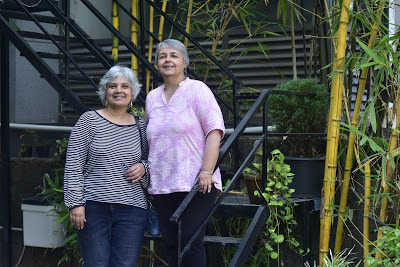
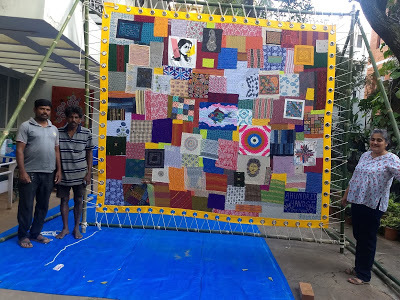
A Hundred Hands Collective, founded by Mala and Sonia Dhawan, held an exhibition at Fort Kochi recently even as they celebrated their tenth anniversary
Pics: Mala and Sonia Dhawan; the Harmony Quilt
By Shevlin Sebastian
The band ‘Highway Haze’ was playing classic Hindi hits at the David Hall in Fort Kochi. When the song ‘Dum Maro Dum’ started, people began dancing. The most striking was a man with a red turban. He is Dwaraka, an artist from Rajasthan, one of the oldest participants of A Hundred Hands Collective which was holding its popular annual exhibition recently.
A variety of textiles, handloom materials, jewellery, artworks, and pottery were on display. Visitors thronged the various stalls, even as the music was going on in full swing. One who looked happy was social entrepreneur Divya Thomas. “Everything was so beautiful,” says Divya. “I bought a lot of gifts for Christmas like handmade coasters and notebooks. The Collective is doing a fantastic job of promoting indigenous art forms, as well as the artists.”
Looking on with bright smiles were the Bengaluru-based sisters Mala and Sonia Dhawan who founded the Collective. “This is our tenth year,” says Mala. “We began with 20 artists and now there are 120.”
They have come from all over India -- Kashmir, Himachal Pradesh, Rajasthan, Gujarat, Uttarakhand, Madhya Pradesh, Assam, Kerala, Karnataka, Tamil Nadu, Orissa and Maharashtra.
This year the theme is ‘Harmony’. “We are celebrating harmony because over the years we got people from all age groups, all religions, and all castes to work together,” says Sonia. And to celebrate this, each artist contributed a small piece to make an 8 feet x 8 feet quilt.
The unusual thing about this Collective that the sisters do not take a commission. “All the money goes to the artisans,” says Mala. “There are no middlemen. We want to empower them by helping to build their own brands.”
Asked how they started the Collective, Mala says that they had begun by supporting a women's farmer group called Vanastree, which is based in the hill station of Sirsi in Karnataka. “The response was very encouraging,” says Mala. “Soon, individual artists and groups came and met us. I realised there was a need to provide a platform for small artistes to showcase their work. That was the catalyst.”
But the urgent desire of the sisters today is to ensure that the traditional arts do not die. “We are encouraging Generation Next,” says Mala. “Most do their B.Com and join a call centre. We want them to feel proud of their traditional art background.”
The Jaipur-based Mohan Kumar is a Mughal miniature artist. But his son Pavan, who is 27, was initially not interested in the art. “He told us the earnings were poor,” says Sonia. “But when his father began to do well, thanks to the exposure through the Collective, including making regular trips to China, Pavan felt encouraged. And one day, he took the plunge. Today, he has become an artist, and a good one at that.”
Incidentally, apart from Kochi, they hold exhibitions in Bengaluru, Coimbatore and Mumbai every year. “Many of the artists earn about 30 per of their annual earnings from these collectives,” says Sonia. “And they establish valuable contacts.”
In Coimbatore, Mala introduced a potter Jasraj to a person who runs a garden. The latter immediately bought 120 terracotta and earthen pots. “He told Jasraj he can buy a full truck, as and when the pots are made,” says
And over the years, there have been many humorous moments. Once Mala overhead two women speaking.
One said, “I have my own ATM.”
The other lady said, “Gosh, please, can you show me where it is.”
“Sure,” said the first lady, who went to the next room and returned with her husband.
Published on December 19, 2019 23:30



